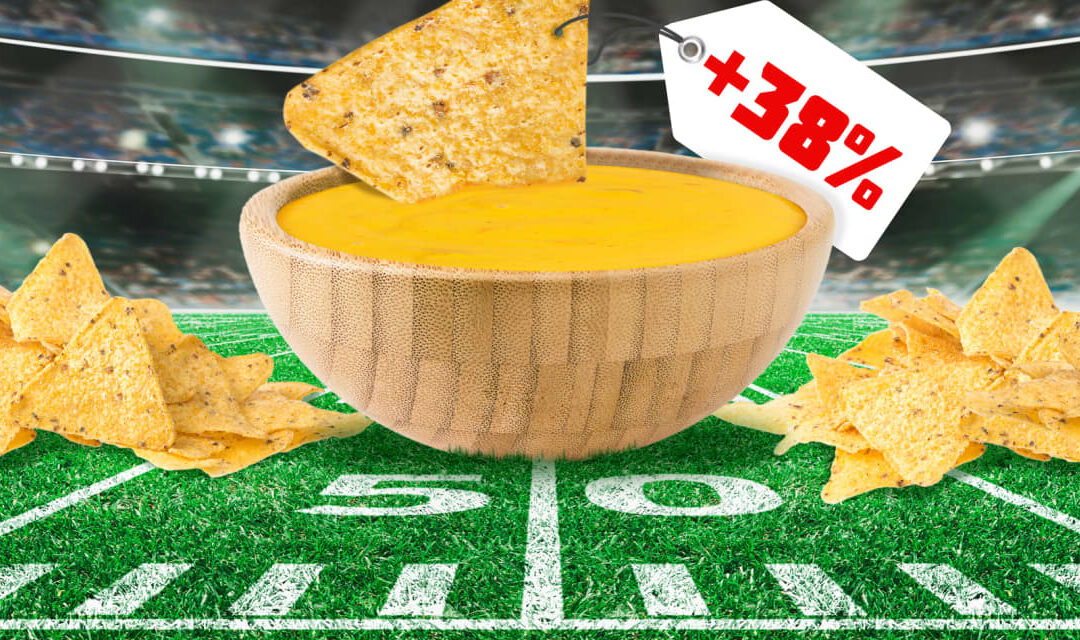Feeding guests at your Super Bowl party will be more expensive this year — but the price increases on game-day snacks aren’t as steep as they were when inflation was hot. Food costs are now rising at a slower rate.
The bad news for party hosts: The price of tortilla chips — a Super Bowl must have (and obvious star of the show) — has shot up more than 38% from last year, to an average of $6.32. And the price of delectable companion dip queso blanco is up by nearly 19%, at $6.08 on average for a 15-ounce jar.
That’s according to an analysis of the average retail cost on Feb. 3 of 14 popular Super Bowl food products by Datasembly, a data company that collects weekly price information from retailers. The prices of chunky chili and guacamole have stabilized since last year, and salsa and burger prices have declined slightly, according to Datasembly.
The item that’s seen the biggest price decrease is vanilla ice cream, down more than 2% to $5.57 for 48 ounces.
Datasembly’s basket of Super Bowl favorites totals $86.99 this year, up by 4% over last year. This increase pales in comparison to the 13.8% rise in last year’s basket, reflecting the overall cooling in grocery inflation.
“Skip the chips and dips at this year’s Super Bowl,” the company said in a statement. Of course, that’s easier said than done: Tortilla chips are the top-selling snack for the Super Bowl, according to Instacart
CART,
Some additional bad news for Kansas City Chiefs fans: The prices for a Super Bowl party basket of goods were up 7.2% over last year in Kansas City, compared with just 3.6% higher in San Francisco, according to Datasembly. The Chiefs will face the San Francisco 49ers in Super Bowl LVIII on Sunday, with kickoff scheduled for 6:30 p.m. Eastern time.
How to save money on Super Bowl party food
There’s hope for Super Bowl party hosts who want to put out a big spread without breaking the bank. One blogger in Wichita, Kan., compared prices for his menu of 28 items at Aldi, Dillons and Walmart
WMT,
concluding that “Aldi is the cheapest place to Super Bowl party food shop.” His total was about $72 there.
A video on TikTok about throwing a Super Bowl party for $18 by shopping at Dollar Tree
DLTR,
— the menu is frozen pizzas, cream-cheese pepper bites, soda, cheese puffs, ranch dressing, popcorn and cookies — has gone viral, with 1.3 million views by Wednesday afternoon.
Home cooks can also save money by making some dishes from scratch — including salsa, guacamole and pizza — rather than buying them prepared. But your cost savings might depend on whether you can make large batches and limit the number of ingredients, as it can be costly to buy a bunch of different products.
If the price of tortilla chips in your local store has become untenable, here’s a very simple recipe that might be cheaper if you have some ingredients in your pantry already.
Food costs remain a burden despite cooling inflation
The overall increase in prices for Super Bowl party food is another reminder that even as inflation has cooled, grocery prices are squeezing consumers. Rising grocery prices have been a significant burden on households, especially low-income households, according to a recent paper from the Groundwork Collaborative, a progressive think tank.
Grocery prices are now 25% higher than they were before the pandemic, according to inflation data from the Bureau of Labor Statistics. This is due to a number of factors including climate change, supply-chain disruptions stemming from the war in Ukraine, and “corporate profiteering,” the Groundwork Collaborative said.
“We don’t have a price-stability problem, we have a price-gouging problem,” said Lindsay Owens, the executive director of Groundwork Collaborative. “Grocery receipts are still too high because corporations have decided to keep them high, even as their input costs have come down.”
Leading chip maker Frito-Lay
PEP,
which owns such brands as Tostitos, Lay’s, Doritos and Ruffles, did not respond to a request for comment.
The White House is pressuring companies — including grocers — to lower prices, saying retail prices have not come down even though costs have. “Our message is a very clear one that the president has and will continue to lean into, which is, if you’re a company whose input prices have come down and you’re not passing those savings along to the consumer, he will call you out,” said Jared Bernstein, the chair of Biden’s Council of Economic Advisers, Reuters reported.
The National Grocers Association, which represents independent grocers, said large chains are forcing suppliers to offset higher production costs by charging smaller retailers more, according to Reuters.
Meanwhile, Kroger
KR,
one of the country’s largest grocers, is seeking regulatory approval to merge with Albertsons
ACI,
saying the deal would lead to lower prices for customers. Some lawmakers have been skeptical about the proposed merger’s potential impact on consumers.
MarketWatch’s personal-finance reporters want to hear from readers about how today’s economy is affecting them and their money — both the good and the bad. We invite you to get in touch with a story idea or a question. Write to readerstories@marketwatch.com. Please include your name and the best way to reach you. A reporter may be in touch.
See also: For Super Bowl LVIII, ‘doink cameras’ and augmented reality await TV viewers









